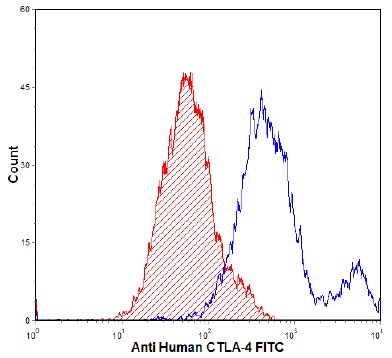CTLA4 Mouse Monoclonal Antibody [Clone ID: A3.4H2.H12]
Other products for "CTLA4"
Specifications
| Product Data | |
| Clone Name | A3.4H2.H12 |
| Applications | FC |
| Recommended Dilution | Intracellular Flow Cytometry. |
| Reactivities | Human |
| Host | Mouse |
| Isotype | IgG2a |
| Clonality | Monoclonal |
| Immunogen | Activated T cells Donor: Balb/c mouse Fusion Partner: SP 2/0 myeloma |
| Specificity | Recognizes Human CTLA-4 (CD152). Other species not tested. |
| Formulation | PBS containing 0.02% Sodium Azide as preservative and EIA grade BSA as a stabilizing protein to bring total protein concentration to 4-5 mg/ml. Label: FITC State: Liquid purified Ig fraction Label: Fluorescein isothiocyanate isomer 1 |
| Concentration | lot specific |
| Purification | Affinity Chromatography on Protein G |
| Conjugation | FITC |
| Storage | Store undiluted at 2-8°C for one month or (in aliquots) at -20°C for longer. This product is photosensitive and should be protected from light. Avoid repeated freezing and thawing. |
| Stability | Shelf life: one year from despatch. |
| Gene Name | Homo sapiens cytotoxic T-lymphocyte associated protein 4 (CTLA4), transcript variant 2 |
| Database Link | |
| Background | Human CTLA-4 (also known as Cytotoxic T lymphocyte-associated antigen-4, CD152) is a structural homologue of T cell co-stimulatory receptor CD28. CTLA-4 binds to the same ligands (CD80 and CD86) as CD28 but with much higher avidity. It is expressed at very low levels on the cell surface of activated T cells, and is found primarily in the post-Golgi or endosomal compartments of the cell. There is a high degree of overall homology between human and mouse CTLA-4 (>70%), and the cytoplasmic domains of the human, mouse and rabbit sequences are completely conserved. CD152 antibodies have shown both stimulatory and negative regulatory roles in functional experiments. |
| Synonyms | CTLA-4 |
| Note | Protocol: FLOW CYTOMETRY ANALYSIS: 1. Prepare cell suspension in Media A. For cell preparations, deplete the red blood cell population with Lympholyte®-H cell separation medium. 2. Wash 2 times. 3. Resuspend the cells to a concentration of 2x10e7 cells/ml in media A. Add 50 μl of this suspension to each tube (each tube will then contain 1 x 10e6 cells, representing 1 test). 4. Fix and permeabilize cells. 5. To each tube, add 1.0 μg of this antibody per 10e6 cells. 6. Vortex the tubes to ensure thorough mixing of antibody and cells. 7. Incubate the tubes for 30 minutes at 4°C. (It is recommended that the tubes are protected from light, since most flurochromes are light sensitive.) 8. Wash 2 times at 4°C. 9. Resuspend the cell pellet in 50 μl ice cold media B. 10. Transfer to suitable tubes for flow cytometric analysis containing 15 μl of propidium iodide at 0.5 mg/ml in PBS. This stains dead cells by intercalating in DNA. Media: A. Phosphate buffered saline (pH 7.2) + 5% normal serum of host species + sodium azide (100 μl of 2M sodium azide in 100 mls). B. Phosphate buffered saline (pH 7.2) + 0.5% Bovine serum albumin + sodium azide (100 μl of 2M sodium azide in 100 mls). Results: Tissue Distribution by Flow Cytometry Analysis: Cell Concentration: 1x10e6 cells per test Antibody Concentration Used: 1.0 μg/10e6 cells Isotypic Control (shaded): FITC Mouse IgG2 |
| Reference Data | |
| Protein Families | Druggable Genome, Transmembrane |
| Protein Pathways | Autoimmune thyroid disease, Cell adhesion molecules (CAMs), T cell receptor signaling pathway |
Documents
| Product Manuals |
| FAQs |
{0} Product Review(s)
0 Product Review(s)
Submit review
Be the first one to submit a review
Product Citations
*Delivery time may vary from web posted schedule. Occasional delays may occur due to unforeseen
complexities in the preparation of your product. International customers may expect an additional 1-2 weeks
in shipping.






























































































































































































































































 Germany
Germany
 Japan
Japan
 United Kingdom
United Kingdom
 China
China



